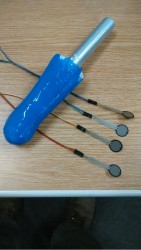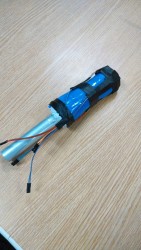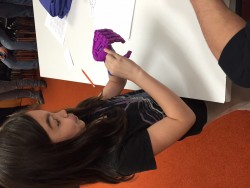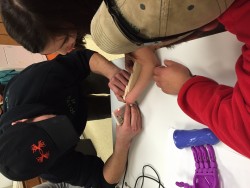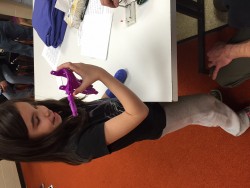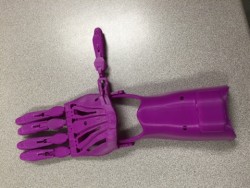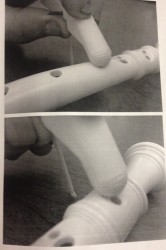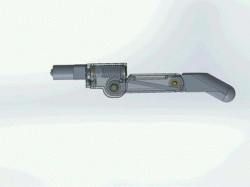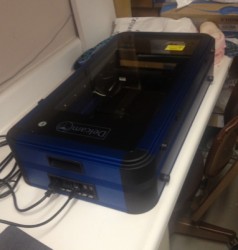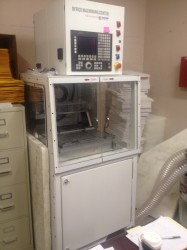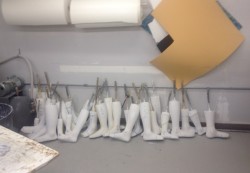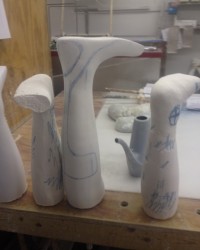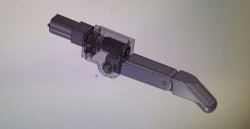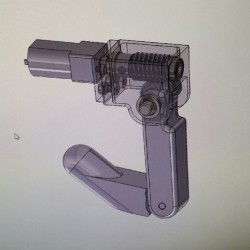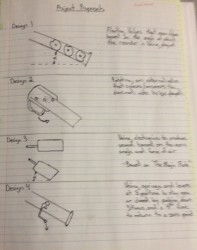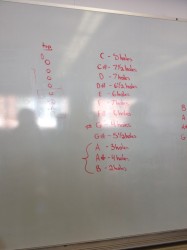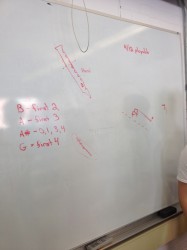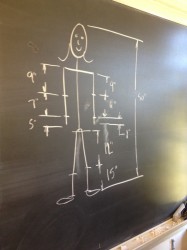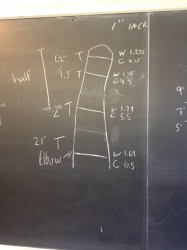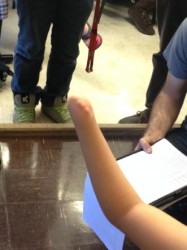2015 Team 7
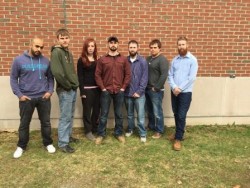
About The Project
The MET 464 class has been given the opportunity to design a device that allows an elementary student in Old Town, ME the chance to learn to play the recorder with her classmates, despite only having the full use of one hand. The challenge of playing a recorder with only one hand will require a lot of thought to not only make the instrument sound like a normal recorder, but also designing the adaptive device so that it remains discrete in comparison to the other children playing in the class.
The goal is to design an adaptive recorder for a client to play now and continue to grow with for the lifespan of her recorder career and ideally something that transfers over to playing the flute. Seven notes will need to be played in the Baroque fingering system. One goal of the design is to make the product as inconspicuous and “normal” looking as possible while also making it easy for the client to assemble/disassemble any device modifications on her own. Safety factors and health issues will need to be considered to avoid producing any part of the recorder that could cause health or safety hazards to either the client or classmates nearby. The recorder will need to be sanitized daily and able to be stored somewhat compactly under the student’s desk or in a closet with the other instruments.
Updates
5/1/15
Final preparations and assembly of the project was completed this week for the Maine Day design competition on April 29th at 9 am. The group was setup and ready to go in Bennett 137 by 8:45am. We entered the tone test and had to describe to the judges that our design did not play the recorder. Because of this we also had to forfeit from playing Camptown Races, which sacrificed us a lot of points in the competition. Nia also felt uncomfortable trying on the cast and prosthetic, which is understandable because the cast was rigid and it was a tight fit to her wiggle. Because the device wasn’t able to play the recorder we did not place as highly in the competition as we would have hoped. However, the prosthetic functioned like a normal hand and was able to do other tasks such as grip and pick up items and hold them for a period of time.
4/24/15
This week we were able to gather the material necessary to produce the final version of the silicone sleeve. The process for this version will be slightly different than the ones made in the past. We decided that the SmoothOn method was coming out too uneven to be practical, so the process needed to change. We decided that we needed to make a negative mold that we could pour the silicone into and then insert the mold of the wiggle into, so the silicone would be formed into a thin layer between the positive and negative. After discussing several different options for making the negative mold, we decided to model the negative after a built up version of the wiggle. We picked up some modeling clay and rolled it into a uniform thickness sheet using a rolling pin. We then draped it over one of the plaster molds of the wiggle, wrapped it around, cut it to size and smoothed out the seam. We added more material to the wrist area and to the wiggle itself, creating a bigger void at the end to place the force sensors so they could be embedded in the material. Shawn spent a substantial amount of time drawing the servo mount and cover contraption to be mounted on the cast.
4/17/15
The team was able to devote the weekend to working on producing another version of the silicone sleeve and design solutions to other aspects of the project. The beginning of the day was spent discussing where we are at with the project and the design components that still needed to be finalized. The main aspects that still need to be resolved are connecting the hand to the cast, a bracing setup to assure that the hand always goes to the right location relative to the recorder, and a solution to the misalignment between the hole spacing on the recorder and the distance between the fingers.
The best solution for mounting the hand to the hard cast was to use a strong epoxy along with the two existing tabs that have through holes for a bolted connection. The decision to have the hand rigidly fixed to the cast versus able to bend at the joint had been made previously. The reason for this was that Nia does not have enough movement in her wrist to comfortably operate the device manually anyway. The epoxy and the two bolted connections will be sufficient enough to secure the hand to the hard cast.
4/10/15
A new vacuum molded hard cast was made for testing purposes and will be used to size the final cast following our visit with Nia. Three group members met with Nia this week to take more calibration measurements and to improve cast/sleeve dimensions. The meeting was very helpful because we were able to eliminate one method of embedding the sensors into the silicone, which we now need to rethink and generate a better idea.
Take Away:
- The sleeve fits well so there is no need to alter the positive mold we are using to produce it.
- The outside contour of the sleeve needs to be altered so that there is less of a drastic protrusion on the end. Making the outer shape of the sleeve, and the corresponding hard cast, as cylindrical as possible will make it easier for Nia to put the assembly on.
- The configuration of the sensors inside the silicone needs to be altered to make them easier to feel and also increase the sensitivity. The hard surface on either side of the sensor that is exactly the size of the pad is most likely the reason the sensors are not working well.
4/3/15
We have assembled a draft of the silicone cast and embedded the force sensors inside. We tested the sensors once hooked up to the required electrical components and they have proven to react sensitive enough to move the fingers accordingly. We have ordered a custom case to fit the recorder and all components which should arrive by the end of next week. We also ordered a battery and pouch to hold the battery and all electronics to avoid wire tangling and simplify where all the electrical components will be located. We will be forming the polypropylene cast this weekend and plan on assembling everything for a test run next week/weekend. A rough idea of how to connect all the physical components is being tested next week once all components are ready.
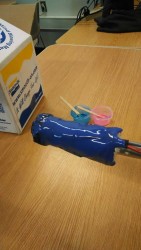
3/27/15
We have decided on final dimensions and made contact with a southern Maine company and the hand will be printed by the end of next week. We ordered more force sensors and silicone to make necessary adjustments to the original cast with one final set left over to embed in the final silicone/polypropylene cast. Four group members traveled to Indian Island School to meet with Nia and show her our prototype of what we’ve accomplished so far. She reacted very positively to our hand design and silicone mold which she confirmed was sized correctly. We measured the force she could apply to the sensors to be ample which means they will be used on the final product.
Pictures show Nia’s first reactions to the prosthetic hand and team members taking measurements of how much force she can apply using her wiggle.
3/20/15
Force sensor programming has been finalized for the meeting with Nia next week. We will calibrate the force sensors and finalize sensor placement when we determine where is most comfortable for Nia. We are in the process of determining a contraption to house all the electronics, ideally something similar to an ipod exercise arm band. The material we are using for the final 3D print of the hand is called Nylon-12 which Hillary researched this week. The material is used for products that require a high endurance strength, likely an application that requires repeated snap fitting.
3/14/15
Dan Scala represented MET Capstone Team 7 today at the Engineering Expo at the University of Southern Maine in Gorham. MET was one of among dozens of tables representing companies and schools throughout Maine.
The Expo Team described the Capstone project to hundreds of parents, children and professional representatives about Nia and her need, the use of 3D printing to produce useful objects and the program as a whole.
The Team also gave away hundreds of 3D printed Space Invaders from the classic arcade game, and custom designed fidget rings that can be assembled and reassembled in a variety of styles and colors.
2/20/15
Jacques, Dan and Shawn traveled to Waterville to meet with the upper extremity specialist Matt Mikosz. Being the upper extremity specialist, Matt has a wide range of experience with prosthetic devices. He has worked with everything from human powered, harness hook devices to the latest versions of the ‘i-limb’ and ‘bebionic’ hands. We discussed briefly how the issue of upper extremity limb loss or deformation with young children does not really have a perfect solution and there is no “one size fits all” solution. Matt has fit children as young as 2 years old with a prosthetic hand or arm. We brought with us the plaster mold of Nia’s arm, the 3D printed E-nabling the Future hand, and also footage of Nia’s range of motion. With all of this material and our discussion Matt was able to get a good sense of the situation and the requirements for a useful prosthetic device. His opinion of our design so far was that it was a good solution to a usable and affordable device. One of the major topics of discussion was his opinion of the use of a silicone material layer on the inside of the casting. He told us that a product they often use is ‘smooth on body double’. He mentioned that the force sensors to be placed in the end of the casting could be imbedded in the silicon solving any concerns with corrosion that might arise from moisture inside the casting. The silicone also provides a significantly greater level of comfort for the individual. Shawn and Dan completed the training necessary to be able to use the 3D printers available at the IMRC(Innovative Media Research and Commercialization Center). We were able to go into detail about how to operate the different interface programs used to control the printers. More advanced training is available if we wish to use more of the equipment at the facility. We plan to attend more training sessions, possibly with more group members, next week. Shawn was able to finish the construction of the frames required to house the sheet of poly in the casting process. Correctly sized servo’s and force sensors have been ordered as well as Smooth-On silicone to be used for creating the cast.
2/13/15
Our Arduino circuit board and servo motors arrived late this week and testing will begin over the weekend and into next week. We received a plaster mold of Nia’s wiggle which will be an enormous help in creating the cast, controls housing, and hand mount. We would like to thank AJ Rutherford for creating a mold for every team over the weekend. We will begin generating a CAD model of the wiggle and a controls housing this week with the hopes of a rough mockup done by the end of next week. Dan and Jacques performed finger measurements with and without the neoprene material. The 3D printed finger alone covers an area of 0.044 in^2, technically a large enough area to cover the recorder hole. With the addition of the neoprene tip, the area the finger can cover is roughly 0.196 in^2, an additional area of 77% which allows the finger accuracy a little bit of leeway/freedom when trying to play notes. Shawn, Abdul, and Dan visited the Hanger Clinic in Bangor for some advice on various aspects of the prosthetic device. The orthotics and prosthetics aspects that were the main focus of the meeting were how to attach the 3D printed hand to the cast and control of finger activation. For the recorder application of the hand we’re going to implement buttons or touch sensors as a method of input to activate the movement of the fingers into specific positions corresponding to certain notes to be played. The idea will involve 4 buttons or touch sensors to be actuated, in a basic North, South, East, West positioning scheme to actuate different note/finger positions on the recorder. The sensors would be placed in the portion of the device where there will be a void where Nia’s “wiggle” will be. It was suggested that the cast be very snug and rigid on her wrist up to her opposable wiggle to avoid any delay between her moving her arm and the wiggle moving to a sensor. If the cast is not tight/rigid enough on her forearm, the little bit of play and wiggle room could cause a delayed reaction in her “wiggle” activating the buttons and could result in missed notes or delayed finger changes.
2/6/15
Now that the hand is made and proven to be relatively easy to recreate, the next step is working on the cast attachment and controls portion of the project. The team tried to make a plaster mold at the end of the week but because the negative was unavailable it will need to be made this weekend. The mold will be used to test out possible casts to attach the hand to the wrist taking into consideration factors like sturdiness, weight, rigidity, comfort, and most importantly, whether it will hold or not. An order has been placed for an Arduino circuit board and servo motors to be tested as a control system for the finger movements which will hopefully arrive early next week and begin testing immediately. An appointment has been made to meet with a local company late next week for a few team members to ask questions and tour the facility which will be very helpful. Our material research brought us closer to a decision by ruling out the use of ninja flex, a material we were once strongly considering for the final product.
1/30/15
A slight update in our design has been made which will incorporate design ideas from an open source organization called E-Nabling The Future which specializes in 3D printed prosthetics designs and kits for free or very inexpensive. The organization, www.enablingthefuture.com, has been extremely willing to help and we would like to thank them for the opportunity to expand on their designs as we move forward. We will be 3D utilizing 3D printing to make as many components as possible to be as time and cost efficient as possible. We 3D printed an entire hand to do testing and make important measurements to apply the model to Nia’s arm and also to determine finger spacing in order to play the required recorder notes. The entire hand mold(components were printed separately) took about 18 hours to print, a fraction of the time it would have taken to machine all these parts. We would like to thank AJ Rutherford for all his help 3D printing and helping us obtain a mold of Nia’s arm as fast as possible. Shawn, Abdul, and Taylor located a place to learn 3D printing and will be utilizing their training to print one of the mockups to be made in the future. Testing has been done using a generic ABS plastic for 3D printing which seems to be plenty strong but we are still exploring other options including ninja flex. Hillary is researching more materials which will ideally be tested and decided on next week.
ABS 3D printed hand
1/23/15
Abdul, Taylor, Shawn, and Dan met with Norman Plourde at Eastern Maine Medical Center to discuss prosthetics and ideas for the project. We decided on a sleeve and casting method to connect the 3D printed hand to Nia’s arm. The entire staff could not have been any more helpful and told us they would like to be of service throughout the remainder of the project as we move forward. Norman provided us with a sleeve we will use when we test the mockup and see how it can connect to the sleeve(all pictured below). We will be making our own mold from the negative provided for further accuracy during the prosthetic design and manufacturing process. The team has decided to slightly alter our original design concept from machining the majority of the prosthetic out of aluminum and delrin to 3D printing the entire hand and manufacturing the accessory components(the pins to connect all the parts) out of aluminum and delrin. The machining process to create all the separate parts would be very time and labor intensive whereas 3D printing is a lot more time and cost effective for our timeline. With 3D printing, a very durable and lightweight prototype can be created in a matter of hours/days using a printer and not valuable man hours. Another advantage of 3D printing is that a replacement part can be made quickly and inexpensively in the event that some component breaks or is misplaced.
1/16/15
The first week back from break involved a lot of housekeeping tasks for the team. A new and updated contract was created, a second semester Gantt chart was created, and the professors obtained a positive and negative model of Nia’s wiggle. The molds were donated by EMMC and the negative can be used to create duplicates of the positive mold for each team. Our team is hoping to get a duplicate of the mold as soon as possible to start taking more detailed measurements for design purposes. We worked on contacting more companies in the area about materials and ergonomics to help us continue to refine our design. We are working on setting up meetings with multiple companies later in the month to hopefully sit down and determine the logistics and time to be expected when designing and creating a prosthetic hand. We are continuing to contact PE’s and are trying to gather as much information as possible before we begin the final phase of the project which is building the prosthetic.
12/12/14
This week all the groups finally revealed their designs they have been working on all semester with a 10 minute presentation to the entire class and other faculty on Monday 12/8 and Wednesday 12/10. Our presentation is included below. A few of us met with a professional engineer to gain some technical/professional advice for design and material usage. Our meeting confirmed that our motor and gear material selection is adequate for the intended operation. We have generated a preliminary set of technical drawings and a bill of materials which can be seen by clicking the links below. We plan to accomplish a number of things over winter break including testing the motor and gear setup with one finger in order to determine how well it works and having the thumb design sent out to be cast. Once the design has been tested and deemed acceptable, we will begin the material ordering process, manufacturing process, and programming/calibrating the electrical components for Nia.
Bill of Materials
https://docs.google.com/spreadsheets/d/1UqBRDJCzdwX0vli5n9VP53g2lGmu9OOhlP4LSHk6syc/edit#gid=176034884
Technical Drawing Packet(PDF)
https://docs.google.com/file/d/0B-xFd4_67MNgNnpWYXF6TTVteUU/edit
12/5/14
After a week off for Thanksgiving break, the group reconvened and immediately began working on updating the drawings packet. Some team members were able to meet or correspond with professionals and consultants to continue to improve the design. We received a lot of positive feedback as well as constructive criticism on the drawings packet and began applying the feedback accordingly. Materials will be ordered to test the mechanical properties of the mockup including the speed, power, and general functionality when in use. One of the 3-D printed design components is pictured below. Since the fall semester is wrapping up, the group is working very hard to have the design completed and ready to build by the beginning of the spring semester. Our building/manufacturing process ideally must begin by the end of January in order to have time to fix any glitches that might arise. We tested our mockup and it seems to be strong enough as a 3D printed ABS material, but it didn’t completely cover the holes as we had expected it to. We would prefer to find a solution to attach to the finger tip instead of redesigning the finger tip to cover the holes. One solution we have come up with is adding a removable neoprene finger tip to the end of the model which can be removed when Nia is not playing the recorder.
3D printed mockup of finger design made of ABS plastic
These photos show a testing session of the mockup to make sure it covers the holes. Because it does not cover the holes completely, we have decided to add a neoprene covering to the finger tips instead of redesigning the shape for this application.
Click the image above for an animated gif of the CAD drawing being fully contracted
11/26
This week the team put in a lot of hours finalizing the SolidWorks drawings which will be turned in for evaluation Monday when the next logbook is due. Along with the drawings we performed the necessary design calculations to make sure the design would work within established design factors. The design is well within the published maximum design standards. We also received a lesson on 3-D printing this week and used the knowledge we gained to decide how we would like to 3-D print our mockup(fill percentage, material, etc.). We will begin our first round of purchasing materials after Thanksgiving break to hopefully begin our first round of analyses on the design before the group separates for Christmas break. Purchases will depend on how fast our submitted purchase orders make it up the chain of approval so ordering last minute is out of the question. A meeting and tour of Maine Orthotics in Portland proved to be very informative about the prosthetics and materials process which has influenced us to use carbon fiber to reinforce our own design. Pictures of the scanner, design modeling machine, stress testing, and a number of limbs waiting for a final coat can be seen below.
Left: Limb Scanner; Right: Limb Modeler; Bottom Left:Limbs ready for skin coating; Bottom Right: Limb stress test
11/14
The team worked on generating a working set of drawings in SolidWorks, which will be used to 3-D print a mockup next week, ideally by 11/19. We are hoping to get design approval soon after the mockup is submitted so we can begin purchasing materials/parts and machining what we need to. More contact was made with medical consultants to get some more information regarding safety and care needed with this type of design. Because of Thanksgiving break and finals right around the corner, the group sat down and made a calendar for meetings and attendance as well as a definitive timeline to avoid problems with the time apart. Setting these strict deadlines will avoid confusion and the need to scramble to get everything done before the semester ends.
Top: CAD model of finger extended; Bottom: CAD model of finger contracted
11/7/2014
This week the team established contact with a number of industry professionals, consultants, and professional engineers to be of some assistance from now until the completion of the project. These resources should prove to be huge assets in the design process. While our design mockup isn’t finished at this date, a basic prototype will be completed by Thanksgiving break. A physical model, even a rudimentary one, will make testing and revising components in the design process much easier to visualize and quantify. Once more in depth measurements are made available, CAD drawings can be finalized and materials can be ordered or planned for production. We have included a table of preliminary prices of a motor, controller, sensors, and a sleeve connection which will be need for each finger(only one sleeve needed).
 Table including prices for motor, motor controller, sensor kit, and sleeve
Table including prices for motor, motor controller, sensor kit, and sleeve
10/31/2014
The team has decided on a prosthetic hand design style to be used and will begin doing more in depth research and planning into materials, ergonomics, and other factors for the project. The group has a number of professional contacts that we will begin contacting as soon as possible to get started as soon as possible since this will be a very complicated and time-consuming product. Although we know we are in for a lot of work, as a group we voted that this would be the most rewarding way to go about enabling Nia to play the recorder and hopefully benefit her in other aspects of daily life as well. A list of companies and organizations that could prove to be assets for the remainder of the project has been generated and contact will be made shortly. We will begin brainstorming ways to make this work(myoelectric, human powered, etc.) and begin drafting as soon as possible.
10/24/2014
This week the team continued to narrow down design ideas from the 10+ design ideas we started with down to 3 very possible ideas. A decision will be made within the next few weeks and at that time a much more in depth design will be agreed upon as well as CAD drawings and a possible early prototype by the end of the semester. We have been looking into material donations or discounts and will be moving forward with that as soon as our design and funding has been finalized. A research into patents has been initiated to ensure our ideas are unique and original. We generated a number of ideas to modify the recorder including external and internal valves, an electronic modification, a spring and lever design, and a foot pedal contraption. We brainstormed these devices to me made of brass, stainless steel, aluminum, ABS plastic, delrin, or wood. We have also been considering the use of a prosthetic but will need to do a lot more research in order to determine whether or not this could be feasible.
Design ideas including a foot pedal device, internal and external valves, electronics, and spring levers
10/17/2014
This week was a shortened week due to fall break, but still a very busy workweek for the team. The team returned from the mini vacation on Wednesday recharged and ready to put in some hard work on the project. The team split up into groups with one group researching possible safety hazards and the other group looing into human factors and ergonomics. Safety hazards for an 8 year old playing the recorder are relatively nonexistent. However, if the student were to bring the modified recorder/apparatus home with younger siblings or relatives around the house, a possible choking hazard could arise if the younger/infant relative got a hold of the device unattended. Safety factors and human factors research will be an ongoing need for the remainder of the project and will be updated as it is obtained.
10/10/2014
This week the team sat down for a few hours as a group to look at current design ideas to try to decide what would be feasible or not. As a group, we constructed a pros and cons list for each design and material based on design criteria, cost, and most importantly, will it work? Some constructive criticism and brainstorming really helped to eliminate some ideas and tweak some ideas to the group’s agreement. Normally the team separates to perform given tasks and returns with them completed at each meeting, however sitting down as a group to discuss things and bounce ideas off each other was a good change of pace and will most likely be implemented every few weeks from now on. We met in a classroom where we could spread out and also write ideas up on the whiteboard as they came to us.
Two pictures from a team meeting detailing what each note would look like on the recorder and which notes will require modification
10/3/2014
The group split up to accomplish different goals this week with Taylor and Matt researching safety issues and possible ADA information that could be of use; Hillary and Shawn did current product and patent research to see what is currently available; Jacques was in charge of examining the client Q&A as well as contacting the music teacher to get a better idea of what is needed for best results; Abdul contacted music stores and recorder companies/manufacturers for possible ideas and donations; and Dan designed the website and purchased a recorder for hands on research by the group. Taylor’s research on government regulations prompted him to arrange a meeting on Saturday 10/4/2014 with a Maine special education specialist and a lawyer to clarify/identify any information that could apply to this project and the client’s needs.
9/26/2014
The prospective client was brave enough to attend the MET 464 class meeting on the morning of Wednesday 9/24/2014 and was very enthusiastic about having her measurements taken in front of the entire class. Some measurements taken included height, weight, and general proportions of both arms to further brainstorm ideas to overcome any obstacles that could arise. With project and design competition requirements relatively open ended at this point, brainstorming included many ideas involving one handed instruments, modified shape/hole placement recorders, a foot operated contraption, and the possible use of a prosthetic.
Left: Overall measurements of Nia; Center: Detailed measurements of Nia’s arm; Right: Image of Nia’s arm
9/19/2014
Groups were assigned this week and our first meeting took place on Friday 9/19/2014. This week’s meeting mostly took care of task delegation and housekeeping matters. The team contract was generated as a group and agreed upon by all team members. The contract deals with grading policies, task delegations, and general expectations of group work.
Team Bios
Jacques Daigle
I am currently a senior in the Mechanical Engineering Technology program with a particular focus in the pulp and paper industry. For the past three summers I have interned with Twin Rivers Paper in the engineering department. My time spent with TRP has given me experience in drafting, project management, and design work. In my spare time I can be found doing something outdoors. Coming from Northern Maine there are not very many things to do for fun other than hunting, fishing, and camping.
Dan Scala
I am a senior in the Mechanical Engineering Technology program with minors in Entrepreneurial Engineering and Renewable Energy Technology. I am very interested in construction and real estate and plan on starting a construction/real estate development company on the side that focuses on renewable energy in the next 5-10 years. Outside of school I enjoy watching movies, the Boston Bruins, and basically all outdoor sports. I interned at the Portland Water District during the summer of 2014 and would ideally like to settle down in the Greater Portland area after graduation.
Hillary Carter
I am a senior at the University of Maine pursuing a B.S. in Mechanical Engineering Technology. For the past two and a half years I have worked at the Advanced Manufacturing Center on the UMaine campus, graduating to the student manager position 9 months ago. Through my experience there I have honed my skills as a CAD designer and as a CNC machinist. I have a passion for knowledge and continuous improvement, utilizing these desires to lead projects and teams to success above and beyond that of expectations. Upon graduation I plan to pursue a career in energy efficiency, with a particular focus in alternative energy and building HVAC design.
Matt Watson
My name is Matt Watson and I am from Hermon, Maine. For the last 4 years I have worked at Somic America, manufacturing components for Toyota vehicles, both as a machine operator and an engineering intern. I enjoy working on anything with a motor and would would like to find work somewhere in the automotive industry after school, hopefully something performance or off-road related.
Shawn Sewall
I grew up in Carmel, Maine and graduated from Hermon High School in 2009. After graduating I took a year and a half off to help my father establish a spray foam insulation company. While I was proud to be a part of creating a good solid business, working full time in the spray foam industry was a major factor in my decision to strive for something bigger. Along with my degree in engineering technology, I will graduate with a minor in renewable energy science and technology.
Abdulwahab Aldakheal
My name is Abdulwahab Aldakheel, I am an international student from Saudi Arabia. I graduated from Jubial Industrial College as a Mechanical Engineer Assistant. I came to the University of Maine to complete my studies to become a mechanical engineer. I have been interested in this field since I was a little kid. I used to open my toys and look how things work from inside and then try to put everything back together. I am really excited to have a job in this field after graduating.
Taylor Jacobs
Taylor Jacobs is in his 4th year at the University of Maine, in the Mechanical Engineering Technology program, with a minor in Electrical Engineering Technology. Originally from Eielson AFB, Alaska, he enjoys working on cars, snowboarding, and snowmobiling.
Sponsors

